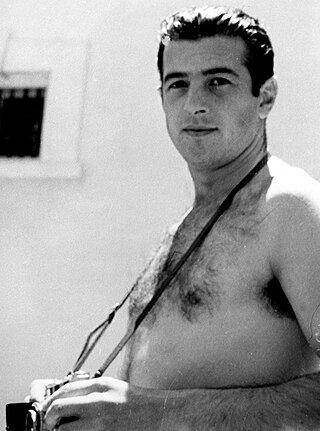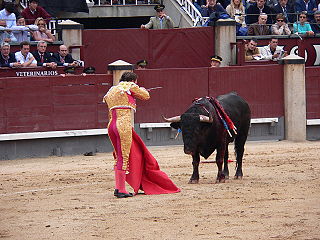
Ronda is a municipality of Spain belonging to the province of Málaga, within the autonomous community of Andalusia.

Pedro Romero Martínez was a bullfighter from the Romero family in Ronda, Spain.

The Plaza de Toros de Ronda is a Bullring in Ronda, it has a diameter of 66 metres (217 ft), surrounded by a passage formed by two rings of stone. There are two layers of seating, each with five raised rows and 136 pillars that make up 68 arches. The Royal Box has a sloping roof covered in Arabic tiles. The design of the main entrance to the bull ring features two Tuscan columns and the royal shield of Spain surround by baroque edging. The main door is large enough to allow horses and carriages to enter the ring, and above the door is an iron wrought balcony that embodies the bullfighting culture.

Francisco Rivera Pérez, better known as Paquirri, was a Spanish bullfighter. He died after being gored by a bull named Avispado at the Pozoblanco bullring. During his career, he was six times borne shoulder-high out through the Great Gate at Las Ventas.

Antonio Ordóñez Araujo was a Spanish bullfighter.

Francisco de Asís Rivera Ordóñez is a Spanish torero or bullfighter.

Cayetano Ordóñez y Aguilera is the patriarch of the Ordóñez family of bullfighters.

Spanish-style bullfighting is a type of bullfighting that is practiced in several Spanish-speaking countries: Spain, Mexico, Ecuador, Venezuela, Peru, as well as in parts of southern France and Portugal. In Colombia it has been outlawed but is being phased out with a full ban coming in effect in 2027. This style of bullfighting involves a physical contest with humans attempting to publicly subdue, immobilize, or kill a bull. The most common bull used is the Spanish Fighting Bull, a type of cattle native to the Iberian Peninsula. This style of bullfighting is seen to be both a sport and performance art. The red colour of the cape is a matter of tradition – bulls are color blind. They attack moving objects; the brightly-colored cape is used to mask blood stains.

Alexander Rupert Fiske-Harrison is an English author, journalist and conservationist.

Bullfighting is a physical contest that involves a bullfighter attempting to subdue, immobilize, or kill a bull, usually according to a set of rules, guidelines, or cultural expectations.

Juan José Padilla is a Spanish torero ('bullfighter'). He became a matador de toros, 'killer of (full-grown) bulls', in the town of his birth, Jerez de la Frontera, on June 18, 1994 when he was 21 years old. He was known as the 'Cyclone of Jerez' and featured heavily, both personally and professionally, in Into The Arena: The World Of The Spanish Bullfight, a shortlisted nominee for the William Hill Sports Book of the Year in 2011.

Manuel Jiménez Moreno, better known as "Chicuelo", was a Spanish bullfighter. His contributions to tauromachy are held by some – writer and bullfighting critic Luis Nieto and writer Ignacio de Cossío Pérez de Mendoza among them – to be substantial, making bullfighting what it is today. This includes the introduction of a now popular move with the bullfighting cape that has been named the chicuelina, inspired by his professional nickname.

Iván Fandiño Barros was a Spanish bullfighter. He died when a bull named Provechito gored him during a bullfight at the bullring in Aire-sur-l'Adour in the south of France, only 343 days after fellow Spanish bullfighter Víctor Barrio had met the same fate.

José Rivera "Riverita" Pérez was a Spanish bullfighter. He was the brother of Paquirri.

Antonio Mejías Jiménez, better known as Antonio Bienvenida, was a Venezuelan-born Spanish bullfighter who belonged to the Bienvenida bullfighting dynasty. Eleven times he came out, borne on his fellow bullfighters' shoulders, through the Great Gate at Las Ventas as one of the most important bullfighting figures of the 1950s. Among bullfighting aficionados, the Bienvenida dynasty has been one of the most glorious in tauromachy's history. It was founded by Manuel Mejías Rapela Bienvenida, nicknamed "El Papa Negro", itself a nickname for the superior general of the Society of Jesus, and in this case, it was meant to distinguish him from the head of the bullfighting "church", Ricardo Torres Reina "Bombita".

José Luis Vázquez Garcés, better known as Pepe Luis Vázquez, the same name that his son would later use professionally, was a Spanish bullfighter, considered one of 20th-century bullfighting's most significant figures.
Ángel Teruel Peñalver, professionally known as Ángel Teruel, was a Spanish bullfighter, the star of the escalafón taurino in the 1960s and early 1970s.

José María Dols Abellán, known professionally as José Mari Manzanares was a Spanish bullfighter, son of the banderillero Pepe Dols and father of José María Dols Samper, likewise a bullfighter.

Francisco Camino Sánchez, known in the bullfighting world as Paco Camino, was a Spanish bullfighter and bull breeder. A bullfighter of the highest order, he dominated tauromachy and was twelve times borne shoulder-high out through the Great Gate at Las Ventas in Madrid, a record bested only by Santiago Martín Sánchez.
Jesús Martínez Barrios, known as Morenito de Aranda is a Spanish bullfighter. Born in a small town in Burgos, he had no family background in bullfighting, but has nonetheless become a well known matador in his own country and abroad. His interests also extend to raising the very cattle that he fights at a farm that he established.

















